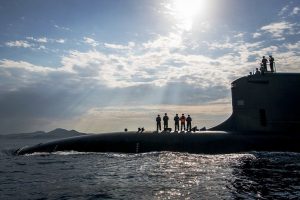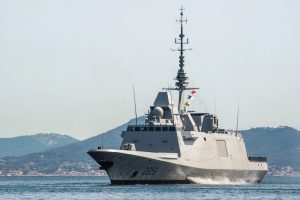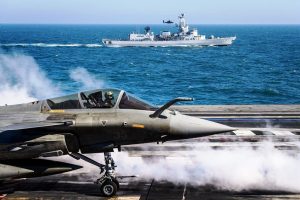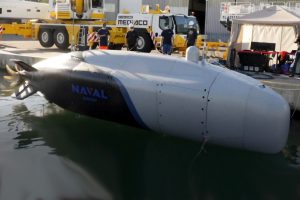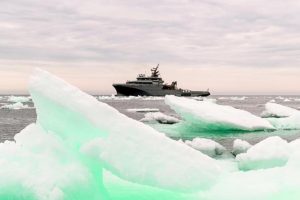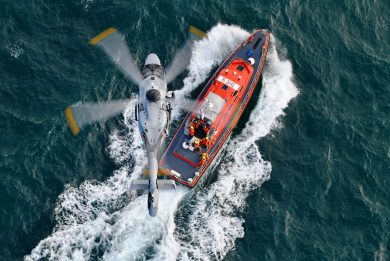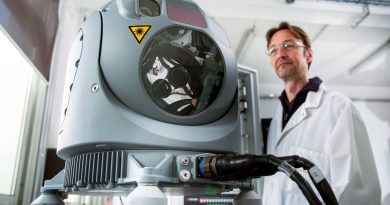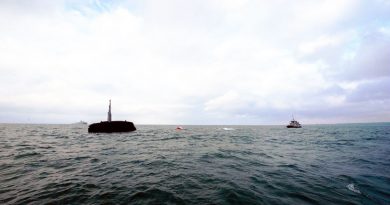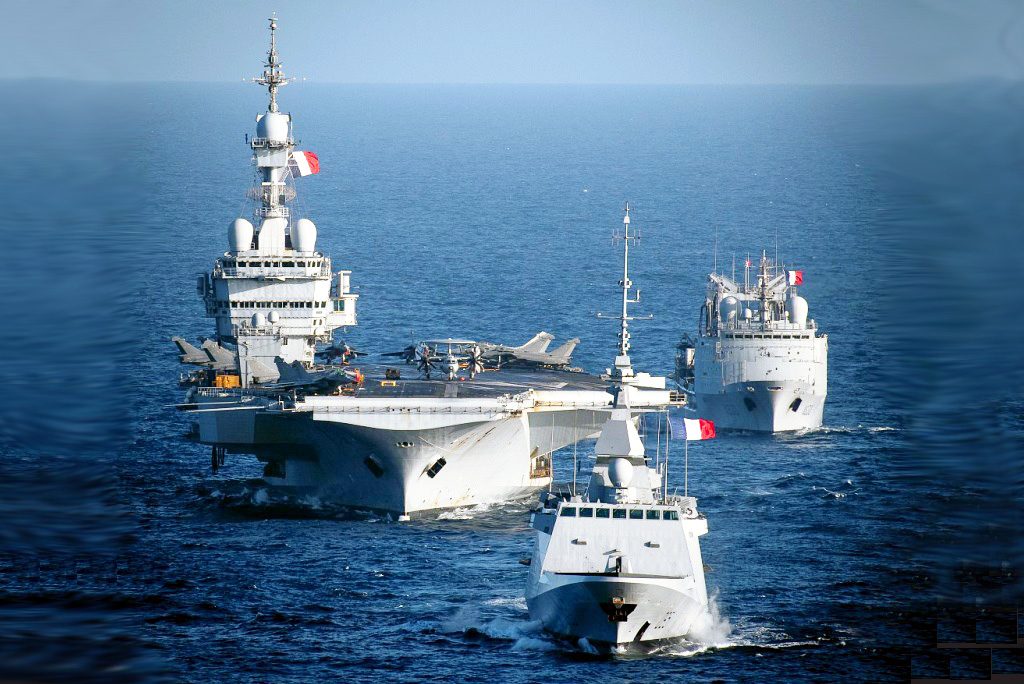
With today’s resources, how the French Navy can meet the challenges of tomorrow
The importance of the Euronaval show for the French Navy, why the show is relevant despite the lessons learned from the Ukrainian conflict, how the French Navy is adapting to the multiplication of operational commitments and the way it is preparing to face current and future challenges… Admiral Pierre Vandier, Chief of Staff of the French Navy answers EDR On-Line questions.
Can you describe your duties as Chief of Staff of the French Navy? What are your missions and what does your daily life look like?
I am an “organic” leader, which, in military parlance, means that I am the provider of resources for the “operational” leader who is the Chief of Staff of the Armed Forces (CEMA). My job is to make sure the Navy is ready for today’s operations and is taking the necessary steps to prepare for tomorrow’s operations.
At present, this covers the fields of training and the availability of forces. The objective is to provide the President of the Republic, Commander in Chief of the Armed Forces, with sailors and ships ready for all the missions entrusted to us. The employment of forces in operations is the responsibility of the CEMA. In this respect, I provide advice and expertise on subjects specific to the Navy.
Together with the Navy staff, we also focus on preparing for the future. This applies to human resources (recruitment, training, retention), in the field of capabilities, as well as in the field of doctrine or concepts of employment of naval forces.
All in all, in a period marked by the renewed strategic importance of the naval domain, there is no shortage of subjects for a Chief of the Navy Staff!
How is the French Navy trying to retain a prominent role when the war in Ukraine has above all highlighted the importance of infantry, artillery, drones and air defence?
The conflict in Ukraine is one illustration among others of a word in upheaval, marked by the use of force to contest law and order. It started behind the scenes in hybrid form, several years ago. Now everything is out in the open. Everyone can see it, it is not limited to one domain. The war that is raging there gives the news an eminently land-based dimension. But we must not take the wrong focus in our analysis and not limit our scope to the dramatic battles taking place in the heart of Europe.
There is a risk of strategic misunderstanding by zooming in too closely on the Ukrainian conflict. As the President of the Republic recently underlined, “never have our problems (…) been so essentially global”. Our economic challenges are global. Our trade is global. Our energy supply is also disrupted by the geopolitical situation. Therefore, our security is global.
The sea is a fluid environment, with no physical boundary other than the coastline. As Mahan said, “the sea is a whole and no part of it can be separated, fortified or defended on its own”.
This fluidity of the environment means we are in daily contact with our competitors. In operations, we see them every day, eye to eye. In the triptych of CEMA’s strategic vision, the sea is already a domain of competition and contestation. It therefore becomes a probable arena for confrontation and potentially conflict.
How is the French Navy adapting to the proliferation of operational commitments in several areas of the globe?
With this question, you perfectly underline the challenge facing the Navy: how, with today’s resources, can we meet the challenges of tomorrow?
The strong boost given by the 2019-2025 military spending bill has allowed us to launch a fleet renewal programme and start to prepare future capabilities. The past year has seen great successes in this movement to renew the Navy’s capabilities, including:
- the Suffren submarine, admitted to active service on 1st June 2022, with two key capabilities: to strike at long distance and discreetly with cruise missiles and to conduct a special operation while diving;
- the admission to active service of the Alsace air defence FREMM in November 2021 and its engagement in operations in the months that followed within the carrier battle group at the beginning of 2022;
- the effort also relates to the protection of our overseas maritime domain. The patrol boat Auguste Benebig began trials in July. It will arrive in New Caledonia in early 2023. The Terrieroo a Terrierooiterai has just been launched in Saint-Malo and will return to Papeete following trials;
- Finally, the BRF (replenishment vessels) that will breathe new life into the logistics fleet. The Jacques Chevallier, the first of this new series, was launched on 29th April 2022 and will begin sea trials at the end of the year.
The efforts made in recent years have made it possible to initiate the renewal of units and will continue in the years to come with the arrival of the first FDI, continued deliveries of overseas patrol boats, the development of ocean patrol boats, etc.
But the problem is not only a matter of resources. It is about learning to “do things differently”, to make the most of what we have. This is the objective of the MERCATOR acceleration plan, launched when I took office and which retains all its relevance in the face of current events. This plan focuses on three areas:
- A state-of-the-art navy, to maintain the technological superiority of our ships. Beyond new programmes, we need to find for example capability “boosters” to improve the technological level of older units, such as for example the installation of the SMDM drone on patrol boats of high sea, or making the best use of technology;
- A navy of talents, based on the sailors themselves, without whom nothing is possible, by modernizing our training systems, by retaining rare skills, as well as by strengthening morale and team spirit;
- A combat-ready navy, by overhauling our operational preparation, to be able to deal with the unexpected in combat.
The naval combat hypothesis is once again relevant. How is the French Navy preparing to deal with it?
Considering the context we have described, naval combat has indeed become a working hypothesis.
At sea, going from low intensity to high intensity, from patrol to combat, is only a matter of orders. Our vessels are deployed with their ammunition in the hold and the sailors on board are qualified for all missions. A warship deployed outside the homeport is able at any time to engage in combat, if the situation requires. It is this requirement that underpins combat readiness in the Navy.
The increase in threats and the determination expressed by our competitors require us to harden our training. More than ever, the art of war is once again becoming that of “contingency”. We therefore need to review our training to deal with the unexpected, shocks, radical change, everything that today is considered improbable. We need to go from “scales” to the jazz orchestra, capable of improvising over time.
I ask crews to thoroughly master their systems. To know them perfectly, from the most automatic modes to degraded modes, which will allow us to gain the upper hand, but also to improve our resilience by being able to deal with breakdowns, combat damage or losses.
More than simple training actions, it is a question of instilling a state of mind which aims to develop in our sailors the spirit of execution, that is to say knowing how to seize opportunities, master one’s “art”, be lucky. It is by forging today the mastery of the fundamentals, the open-mindedness and the pugnacity of our sailors, that we will know how to transform our operational preparation into combat skill when the day comes.
In November 2021, the entire Navy was engaged in the POLARIS exercise, which brought together for 16 days the carrier battle group, 24 ships, 65 aircraft and 6,000 soldiers, including 4,000 sailors from 6 nations. This is the founding impetus for a renewed approach to Navy operational readiness.
One of the future challenges for armed forces is to acquire robots or underwater drones capable of operating at depths of up to 6,000m, such as those used by France’s Ifremer oceanographic institute for research. Today, the French Navy only has two robots of its own, which cannot go beyond 2,000m. What is the situation on this topic?
The seabed is a discontinuous and complex environment, hostile to humans and difficult to reach. It therefore remains largely unknown.
It is becoming a sovereignty issue for several reasons: because our information flows depend on it, or because at a time when resources are increasingly limited, the riches of the seabed generate greed and plunder.
But what is not guarded is one day looted and what is looted is one day contested. Based on this observation, France has therefore defined a seabed strategy, which has been adapted for the Navy.
First of all, we need to know this new environment. Then, we must monitor to find out what is happening there, identify any disturbances. Finally, we want to have a capacity for intervention, to have a capacity for action. Our ambition is to be able to act down to 6,000m depth. With this capacity, 97% of the seabed is accessible.
At a time of global warming, to what extent is the protection of the environment and biodiversity a major concern for the French Navy? What are your actions on this issue?
The Navy is at the forefront of monitoring climate change and its impact on the environment: essentially because we sail every ocean in the world every day.
To measure the effect of climate change on the environment and biodiversity, here too we need to know, monitor and be able to intervene:
- Gain knowledge, through participation in scientific programmes. As such, the Navy has just signed a protocol with Sorbonne University, as part of the Bougainville mission, for the widespread collection of data relating to the evolution of plankton (which captures CO2 and is a basic food for fisheries resources) via onboard sensors on our overseas support ships;
- Monitor, using systems on land, at sea, in the seabed or in space, to guarantee the protection of our waters and prevent the plundering of resources. We have no choice but to be present, and this is particularly true for the huge EEZ for which we are responsible overseas;
- Take action, more particularly during extreme climatic events, to bring relief to populations, or in the event of pollution.
What does the Euronaval show represents for you? Why is it a Don’t Miss event for the French Navy?
In the naval field, failure to keep pace in terms of capability is inexcusable. “The naval force” is a technical weapon. We therefore need to have the most innovative technologies that are the most suited to the combat of tomorrow. History shows, however, that overconfidence in technological novelty can also lead to a dead end.
There is therefore a strong challenge to discuss regularly with the engineers and specialists who build our ships, our planes or our submarines. We have to confront their ideas with the reality of conditions at sea and operational experience. Conversely, we sailors must be able to think about new employment concepts, applications opened up by technological innovation.
Even more than providing a showcase for our know-how, it is this mutual exchange that makes Euronaval an essential event for the Navy.


